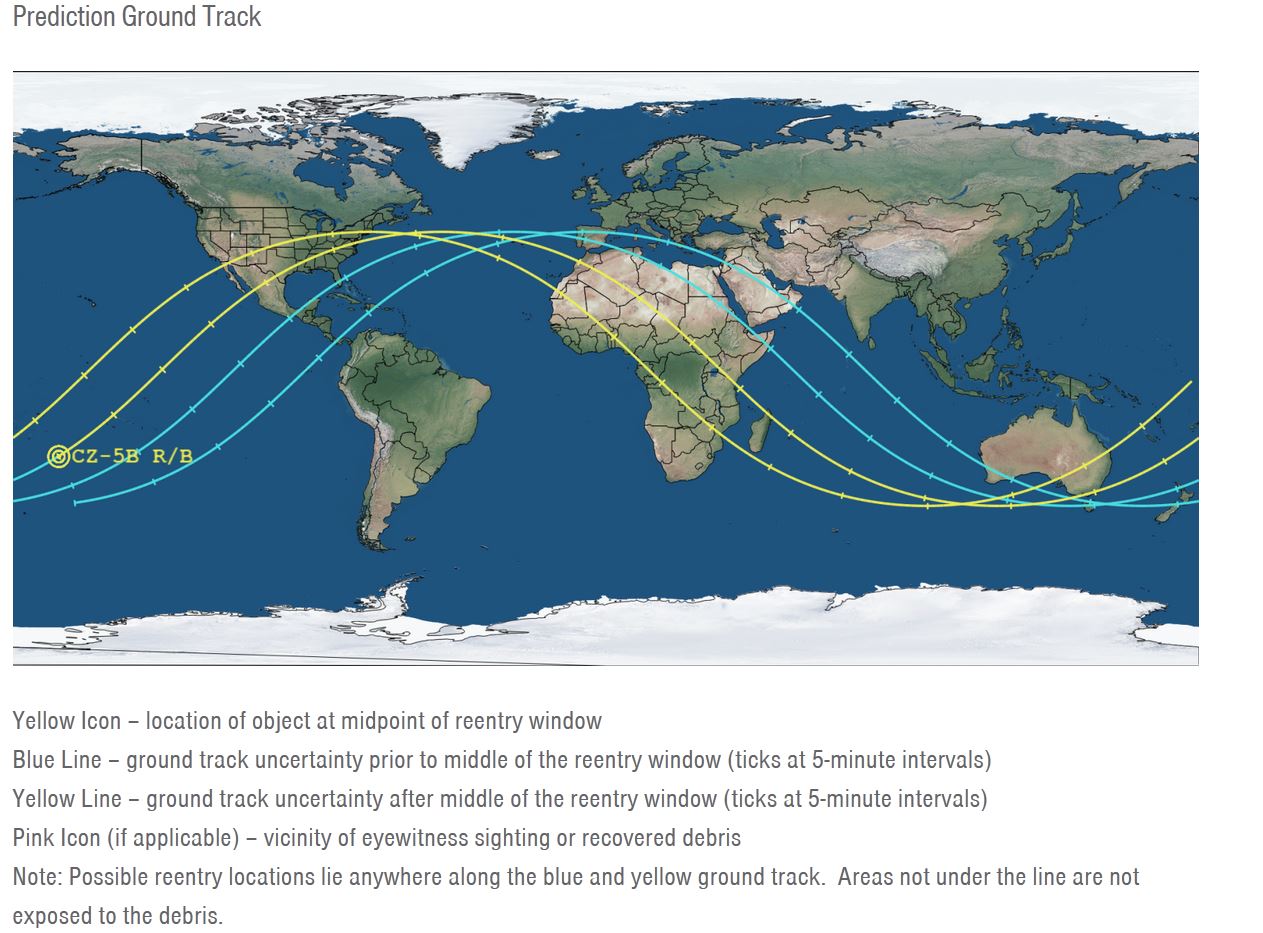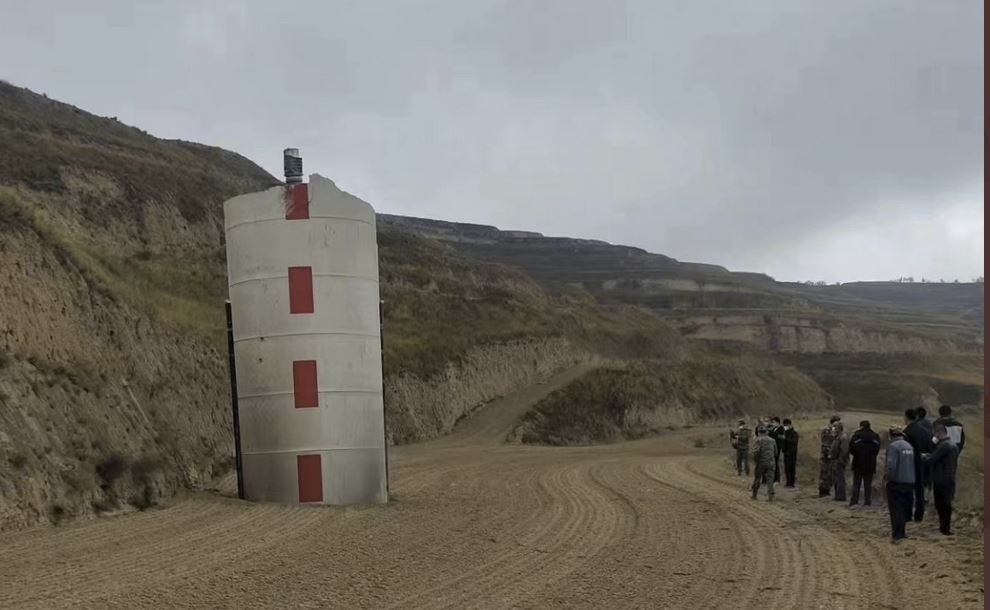Well that was lucky. Early reports suggest the Chinese space junk from the launch four days ago has crashed in the Pacific 1,000 km short of Mexico. However, if I am reading those maps (below) correctly, on this uncontrolled reentry it only missed Australia and New Zealand by half an hour, and just a few minutes later and it would have “landed” somewhere in Mexico or maybe Florida. (Now that would have been a November surprise).
Despite what China says, this is not what the rest of the world does:
China Lucks Out Again as Out-of-Control Rocket Booster Falls in the Pacific
Kenneth Chang, New York Times
It was China’s latest round of celestial roulette involving a deliberate uncontrolled atmospheric re-entry. The rocket stage, by design, did not include a system to guide it into a specific spot on Earth, far away from people.
“The thing I want to point out about this is that we, the world, don’t deliberately launch things this big intending them to fall wherever,” Ted Muelhaupt, a consultant for the Aerospace Corporation, a nonprofit group largely financed by the U.S. government that performs research and analysis, said in a news conference on Wednesday. “We haven’t done that for 50 years.”
There’s a callous attitude of disregard here in these excuses:
However, Zhao Lijian, a foreign ministry spokesman, on Friday rejected the notion that China’s handling of the Long March 5B rockets represented anything unusual. “I would like to stress that China has always carried out activities in the peaceful use of outer space in accordance with international law and international practice — re-entry of the last stage of a rocket is an international practice,” he said.
Mr. Zhao added that the Long March 5B had been designed to pose less danger upon re-entry. The rocket “is designed with special technology; most of the components will burn up and be destroyed during the re-entry…
It broke no laws because there are no international laws on reentry. This is not “international practice”, and if it had crashed in a populated area, it would have killed people.
Whew! 23-ton Chinese rocket debris falls to Earth over Pacific Ocean
Brett Tingley, Space.com
Other rockets are designed with measures in place to ensure their core stages are steered into the ocean after launch, while others like SpaceX’s workhorse Falcon 9, are designed to come down in one piece and be reused. China’s most powerful rocket has no such measures in place.
Unfortunately, there are no international agreements in place to prevent these incidents from occurring again in the future, said Marlon Sorge, Executive Director for The Aerospace Corporation’s Center for Orbital and Reentry Debris Studies during a media briefing on Wednesday (Nov. 2). “And the reality is there aren’t any real laws, treaties, internationally that govern what you’re allowed to do in terms of reentry,” Sorge said
And past crashes did leave debris:
China, like always refuses to take responsibility for its falling rocket, instead claiming that it will burn up on re-entry. However, on three separate occasions, metal from their rockets has made impact on the Earth. Once, they managed to damage an entire village.
On the three previous launches by the Chinese space agency where they have used a similar rocket, back in 2020, 2021, and 2022, large chunks of debris damaged villages in the Republic of Cote d’Ivoire, fell into the Indian Ocean, and landed near villages in Borneo, respectively. Fortunately, no one has yet been injured by this falling debris.
300 flights over Spain were delayed while they waited for the space junk to pass over.
According to Alex on twitter, “The Chinese #CZ5B rocket flew over Catalonia a while ago at a height of 148 km and a speed of more than 28,000 km/h.” Which makes it 140 km above most planes. Still, at some point, 23 ton objects moving at Mach 22 through your airspace will surely be breaking some laws.
Flights were cleared north of Madrid.
US Aerospace published a prediction of the last hours of this space hazard
Judging by reports, it went over northern Spain, past the UAE, over Western Australia and New Zealand and then crashed 1000 km short of Mexico.
Note the tick marks on the path show how far this travels in five minutes. It was a 35 minute flight from Spain to Australia. (I wish I’d known to look out the window as it went past Perth).

Click to enlarge | Aerospace
China does not know how to play diplomat, and is not even trying. It is treating the world like a trash can. Careless with rockets. Careless with viruses.
How much more would it have cost to add in the last stage small burner to control that reentry?
Apparently China will try this again next year.
UPDATE: For those who believe CCP promises that the craft will burn up, here is past debris.

Shoo 👀 A cropland in Gansu got struck by a large chunk of Long March 2D Y72 debris Twitter
UPDATE: #2 Jonathon McDowell Astrophysicist at Harvard says of the photo above that “The debris …is a suborbital stage of the orbital launch, so more intact that a typical orbital debris reentry.”

Rocket debris believed to be from China’s Long March 5B (CZ-5B) booster rocket were found by fishermen near the Mindoro Strait, the Philippine Coast Guard (PCG) confirmed. (Photo courtesy of PCG Station Mamburao)
UPDATE #2:
MV wisely points out these are not blackened. Apparently they are likely space trash from “suborbital” parts early after the launch. They don’t show whether a 23 ton stage would burn up but they do show that the CCP treats the world like its trash can.
But other parts appear to have crashed on land in 2020, showing that the CCP are not being honest when they claim their reentries burn up:
See the Newsweek story. McDowell says the timing and location suggest it might be.
“For a large object like this, dense pieces like parts of the rocket engines could survive reentry and crash to Earth,” McDowell told CNN. “Once they reach the lower atmosphere they are traveling relatively slowly, so worst case is they could take out a house.” ““I conclude that the objects seen in Mahounou, and at least some of the other objects from the Cote d’Ivore region whose photos are being circulated in African media, are very likely parts of the Chinese rocket stage,” McDowell wrote on Twitter.”
It was an 18 ton stage, and there was seismic evidence supporting debris hitting the ground too.

 …
…